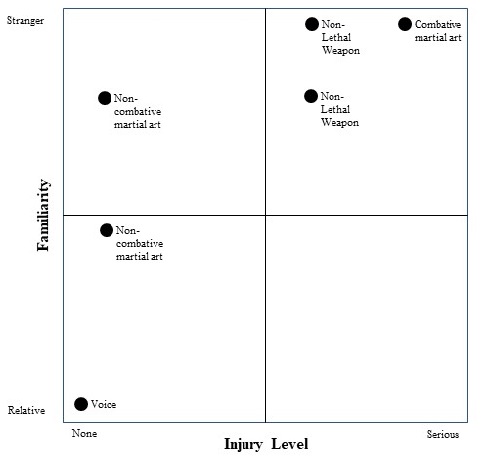Why do you need to know non-lethal self-defense techniques and weapons?
Most personal conflicts that escalate to violent physical contact do not require a lethal response. You have the right to protect yourself and property. I would extend that to your dependents, also. That’s not a legal opinion, of course. Using excessive force to protect yourself can put you in an awkward situation, both legally and socially.
Example:
An emergency responder may need to prevent a determined and aggressive adolescent child from entering a collapsing structure to rescue their pet gecko. The responder needs to be able to neutralize the situation without causing serious injury to the child.
Even organized social situations can unexpectedly become violent. Parents watching their kids’ soccer games can lose their composure quickly and unexpectedly. Some don’t know how to recover themselves from a sporting disagreement, so the situation escalates into violence.
During an emergency situation, you may be faced with a violent friend or relative. If you are at a hospital or elderly care facility, you may need to protect yourself from an aggressive or medicated patient. Emergency situations can cause people to behave unnaturally aggressive and irrational.
How can you defend yourself without inflicting serious physical damage or even death?
During a leadership workshop, a colleague said that he had achieved a high proficiency in Kung Fu. In a conflict with an inebriated acquaintance, he was defenseless. He was not able to utilize his Kung Fu expertise, because of inflecting injuries and probable lethality to his friend. He discontinued his Kung Fu practice and began practicing Aikido.
My solution for non-lethal self-defense was to practice and develop some proficiency in Aikido. It is sometimes called the gentle martial art. There are no kicks or punches in Aikido. It is defensive. I’ve practiced with seventy-plus-year-olds. So, you don’t need strength or speed to be effective. It’s not appropriate for every situation, but for non-lethal self-defense it can work well. Aikido was developed in Japan following World War II. A Korean version was later developed. It’s called Hapkido.
Other, more recognizable, martial arts are represented as defensive. It was explained to me, that the philosophy is to anticipate an attack and preempt it. Get the first punch or kick, then keep punching and kicking until the (anticipated) adversary is incapacitated. That’s not going to work if the adversary is a mentally impaired adult who is just trying to give you a hug. The combative martial arts do have their place, though.
Having proficiency in a martial art or other fighting skill may not help you neutralize someone who is (legally or illegally) highly medicated.
Level of physical injury you are willing to inflect
For some, non-lethal means they will whack an intruder with a baseball bat, zap them with a stun device or shoot them with non-lethal bullets. Those methods are non-lethal but can cause significant injury on the assailant. That is understandable, if it’s a stranger and credible threat. There is always the chance that an intruder is just a family member getting out of bed for a drink of water. In that situation, you may regret the baseball bat strategy. Self-defense requires measured response levels.
Do you need to maintain a relationship with the assailant after you neutralize them?
A variable in determining your response level is your relationship with the assailant. A stranger at a window of your house is different than a neighbor at a window. There could be situations at a social activity with your co-works that could escalate into a self-defense situation. In that situation, you probably wouldn’t want to break your boss’ elbow. A stranger may require a more damaging response to neutralize the attack.
Level of threat
Another variable to consider in determining your response is the level of threat. An inebriated friend may not require a damaging response to neutralize the situation. If the assailant is an inebriated stranger, you don’t know the extent of their attack. That situation may require a more damaging response to neutralize the attack.
This matrix may help you in considering your response level. Considering the various situations in advance, will better position you to make timely decisions. Self-defense situations can develop quickly and without warning. The more you have prepared, the more likely you will make the appropriate response.

Avoid threatening situations
An often-overlooked non-lethal self-defense technique is to recognize possible threats and avoid them. A friend of an acquaintance gets violent when he drinks alcoholic beverages, excessively. Everyone knows it. My acquaintance wore a knot on his forehead to his wedding. It was caused by his buddy’s class ring during his bachelor party. It was predictable and totally avoidable.
There are certain areas of each town or city that present a higher risk of personal physical danger. During an emergency, you can mitigate the risk by avoiding that area. If you can’t avoid it, be sure to have capable support people – in large numbers. I realize that sounds simple and possibly trite, but curiosity can overcome common sense.
During civil disobedience events, consider watching them on television in a safe location. Peaceful demonstrations are less risky but avoid the potentially violent situations. It is common to see people wearing provocative attire and carrying provocative signs at an opposing candidate’s political rally. There is a time and place for discourse.
An ounce of prevention is worth a pound of cure!
Situational awareness is a basic self-defense technique
As mentioned above, your physical self-defense skills may not be effective on highly medicated aggressors. Be aware of the condition of the potential-threating people in your space.
An important part of situational awareness is having an exit strategy. Know how to escape a dangerous situation, before you get trapped. Don’t depend entirely on your self-defense skills or non-lethal weapons. As you enter a venue, identify a couple exit strategies.
In a neighborhood emergency, it’s wise to know your surroundings. Choke points can take the form of low-water bridges, flood vulnerabilities, narrow roads that can become easily blocked, by stalled cars, tree limbs or other debris. Knowing and monitoring the exit choke points can be valuable, if you need to make a hasty exit to a safer location.
Situational awareness in public areas can help you identify and avoid threatening situations. If you are preoccupied as you walk, you make yourself a candidate for a violent encounter. Be engaged with your surroundings. Headphones or texting can make you a prime target for criminals seeking victims.
The sooner you recognize a potential threat, the more options you give yourself. Threats can take the form of criminals, animals, low hanging obstacles and even cracks in the sidewalk. Be subtle, but aware of your surroundings.
Non-Lethal Weapons
There is an assortment of weapons for non-lethal self-defense. They range from a sophisticated stun device to a simple wooden kubaton. Even a flashlight can be an effective non-lethal weapon, both as a baton and blinding weapon.
The effective distance is a consideration for weapon selection.
- Close – one arm length
You need to be within arm’s reach of an assailant to effectively use a kubaton or knife. Some stun devices require you to be able to touch the assailant with the device. These items are usually small in size and easily concealed for everyday carry.
Shouting can be effective at close range. A whistle near the ear of an assailant can cause a reaction that can provide space to escape. There are some electronic personal alarm devices can also help with an escape. Loud noises can also attract help.
In some situations, a bright light in the eyes of the assailant can temporarily blind the assailant and provide an escape opportunity. Some flashlights can be used to create a strobe light that can be disorienting for an assailant. The ones with a thumb-controlled on/off button are effective for creating a strobe. Effects on non-human assailants vary.
- Short distance – two or three arm lengths
Pepper spray can be used at two or three arm lengths. It is most effective when applied to the assailant’s eyes and nose. Some stun devices can reach beyond the and arm length. It was explained to me that discharging a stun device, without even touching it, will encourage a dog to retreat. I haven’t confirmed that with an actual test, though.
- Beyond short distance
Bear spray is a longer-distance pepper spray. Some bear sprays claim a 25-foot spray stream. Some stun guns can reach a target 15-feet away. They are usually a single use device, though. Other options include non-lethal rounds for conventional guns. This can be salt-load shotgun shells and (hard) rubber bullets. I’ve seen some pretty creative loads for shotgun shells including bean bags.
Sonic weapons are also a consideration. These can be hand-held-sized or larger. They emit a sonic sound wave that can temporarily affect an assailant. The affects can include ear pain, nausea and headaches. The effective distance varies, but hand-held devices can reach targets out to 25 feet. Affects on non-human assailants vary.
Airsoft guns are another non-lethal weapon to add to your arsenal. The range is usually around 100 meters. They can also be used for shooting proficiency, rather than a convention gun. By using air soft guns for proficiency shooting, you can set-up a range inside (or outside) your home to eliminate range costs and reduce ammo expense.
Summary
Non-lethal self-defense is just as important as lethal force self-defense. You may agree that using non-lethal self-defense is more likely than lethal-force self-defense. In selecting non-lethal skills and weapons, you should consider:
- Effective distance
- The level of physical injury you are willing to inflect
- Do you need to need to maintain a relationship with the assailant after neutralizing them, e.g., a relative, boss, stranger, etc.?
The methods and weapons that you select will require practice to develop a competency level. If you select a weapon, it needs to be available. To most, that is obvious and assumed, but there are many runners who are attached on the running trail. They compromise their situation awareness with earbuds and don’t carry a weapon.
To bring this back to emergency preparation, in an emergency, there can be self-interested people who can do you harm. You may also encounter irrational, shocked and confused people who can (unintentionally) harm you. Prepare yourself before you find yourself in a self-defense situation.
Lastly, when you consider a non-lethal self-defense weapon, remember that it could be taken from you and used against you.
 |
By Roger Eaton Over thirty years of experience in information technology and over seventeen years of experience in emergency services converged to inspire Eaton to develop Prep Smartz, emergency management software and Prep Smartz Academy. |


